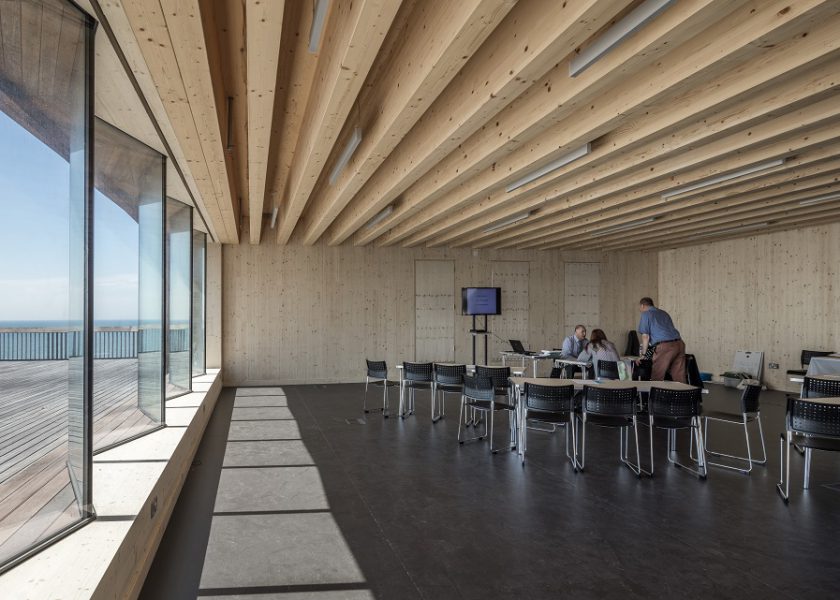Why using more timber is crucial for public sector projects
24/08/2022

Expanding the use of timber for public sector projects has never been more important. Andrew Carpenter, Chief Executive at the Structural Timber Association, looks at the current situation and the benefits of timber for these projects.
The UK has a legally binding target to achieve net zero by 2050 and at COP26 the Government made a commitment to achieve 68% reductions in carbon emissions by 2030 – less than a decade away.
However, as noted in the recent House of Commons Environmental Audit Committee report, there has been minimal guidance from the Government on how this can be achieved. The report also underlines that the policies that have been introduced have focused on reducing operational rather than embodied carbon emissions – the greenhouse gas emissions associated with the production of materials and the construction process.
In contrast, in 2020, the French Government announced new legislation that would require all public sector construction projects to use at least 50% timber or other bio-based materials. This includes the 2024 Paris Olympic and Paralympic Games, which aim to be the most environmentally conscious Games yet. A target was set to achieve a 55% reduction in the carbon footprint compared with the Summer Games in London and Rio. For example, the Olympic and Paralympic Village will be constructed using 100% bio-based materials and use 100% green energy.
Despite no such commitment being made in the UK, there are intensifying calls to increase the use of low carbon materials in public sector projects. In December 2021, the Independent Review of Public Sector Construction Frameworks led by Professor David Mosey published its findings and called for the creation of a Gold Standard for the procurement on public sector developments. Recommendation 3 of the review is to “Require that all public sector construction frameworks prioritise safety, net zero carbon and the Compact with Industry [the agreement between the industry and the Government on how public sector works should be approached].” In essence, framework providers, clients and suppliers would need to show how their framework strategy, procurement and management would achieve these goals.
This was supported by the previously mentioned House of Commons Environmental Audit Committee report published in May, which looks at how sustainability in the built environment can be improved. The report highlights that as a significant buyer of construction materials through public sector procurement, the Government is in a position to drive demand for low carbon materials.
A significant part of reaching net zero for new buildings will be lowering the embodied carbon. Timber is a low carbon material due to the fact that trees absorb and store CO2 while they are growing. As a result, for every cubic metre of timber used in construction, 0.9 tonnes of CO2 is sequestered and stored for the lifetime of the building.
A structural timber frame based approach has huge benefits for the public sector. Firstly, build times can be reduced significantly. This has real relevance for the construction of schools as many areas of the country are struggling with a shortfall of places, and therefore need new schools to be delivered as quickly as possible. Last year, Bristol City Council reported that it lacked almost 300 school places for pupils due to start secondary school in September 2023, rising to 515 for the 2024 school year. Similarly, earlier this year a shortage of 700 places for pupils in the Harrogate area for 2025 was revealed.
Structural timber frame construction can also reduce disruption to the local community as the speed of build shortens the overall project timeframes. Additionally, timber is lighter than many other construction materials and structural timber specifically has larger, offsite constructed, sub-components. Therefore, fewer vehicles are required to bring the necessary materials to site and in turn this minimises traffic issues.
Finally, in addition to the project specific and environmental benefits, there is a strong argument for the Government encouraging or even requiring the use of timber in the public sector. One of the biggest barriers to the use of low carbon materials is that many in the construction sector are conservative and reluctant to deviate from the methods they are familiar with. This is understandable given the importance of getting the design and construction of a building right. There is an opportunity for the public sector to lead the way and provide further demonstration to others in the industry what can be achieved. However, getting the industry to consider more extensive use of timber may need action from the Government, and the first step, as in France, may be to require the use of timber and other sustainable materials where public money is being spent.
The public sector is an area of construction where expanding the use of timber has many potential advantages. At the STA, we are calling on the Government to make a commitment to promote the use of sustainable materials, especially timber, and use its influence over the construction of schools, hospitals and other public buildings to drive their adoption.